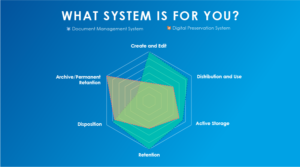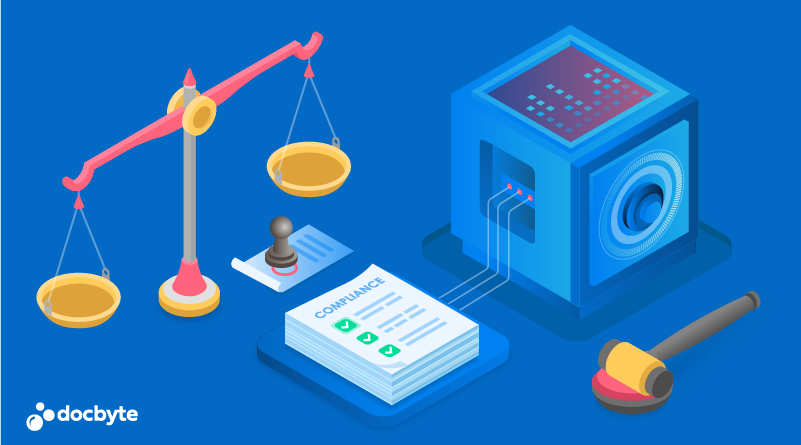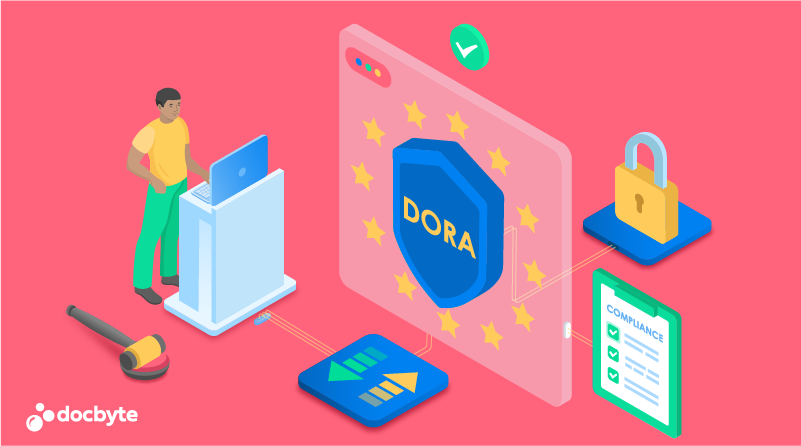Whenever we chat with our clients about their approach to “Digital Archiving,” their common reply is, “No problem, we’re covered! We use a DMS or have a backup solution.”
While these are valuable solutions for your organization, we must clarify– They are not digital preservation solutions. For simplicity, let’s use Digital Preservation instead of Qualified Electronic Archiving (QeA), with the latter being Digital Preservation with some extra “add-ons” for enhanced trust.
This blog will help you better understand that while a DMS serves your organization’s current needs and keeps your business operational, it may need more depth for comprehensive digital preservation. Find out the benefits of Digital Preservation, Qualified Electronic Archiving, and the limitations of alternatives.
The Benefits of A Document Management System
A company needs a DMS because a Document Management System (DMS) typically encompasses a range of essential functionalities to streamline document handling within an organization. It gives full version control to enable efficient tracking and management of document revisions.
The biggest benefit of DMS is that it gives you full control over document access and edits so you are aware about who has checked in and checked out of the document. So this enhances the security and integrity of the data and is seamlessly integrated with other business systems, such as ERP and CRM, for enhanced workflow efficiency.
Mobile access features are a bonus feature of a DMS to facilitate document retrieval and collaboration. Altogether, these functionalities contribute to the effective management and utilization of digital documents in a business environment.
What Is Digital Preservation?
Digital preservation is the ease of accessibility and usability over a period of time, avoiding data loss or corruption. You may be required to include planned and conscious efforts to protect digital assets, addressing challenges such as file format obsolescence and technological changes.
However, it’s important to note that by default digital preservation lacks specific regulations and requirements related to preservation as defined in the eIDAS (Electronic Identification and Trust Services) framework.
Read our latest blog about the importance of digital preservation strategies. We have discussed three key approaches – Refreshment, Migration, and Emulation. Find out which strategy perfectly suits your buisness requirements.
Why Do You Need a Digital Preservation Strategy?
Digital preservation directly contributes to ensure long-term access and usability of digital assets, safeguarding valuable data, protecting cultural heritage, and ensuring future generations can access and learn from our digital information.
A Digital Preservation Strategy is crucial for companies dealing with critical and valuable digital assets that require long-term accessibility and usability. Unlike basic Document Management Software (DMS), a Digital Preservation Strategy is particularly beneficial for organizations that:
- Deal with historical, cultural, or archival data, where the preservation of digital assets is crucial for maintaining cultural heritage or complying with regulatory requirements.
- Organizations involved in research or scientific endeavors that produce valuable data need a Digital Preservation Strategy to ensure the long-term integrity and accessibility of their findings.
- Government agencies that handle sensitive information benefit from a Digital Preservation Strategy, ensuring the authenticity and legal admissibility of archived records.
Industries subject to stringent regulations, such as healthcare, finance, and pharmaceuticals, where compliance and data integrity are paramount, find a Digital Preservation Strategy crucial for meeting industry-specific requirements.
Main Functionalities of Digital Preservation:
These are requirements that a proper Digital Preservation solution should cover and the benefits it offers the businesses:
| Main Functionalities of Digital Preservation |
|
Actively Manage and Maintain digital assets, not just passive storage |
|
Address File Format Obsolescence |
|
Ensure Ongoing Accessibility and Usability by adapting to technological changes over time |
|
Maintain Metadata and Context by providing the necessary information for understanding and utilizing the data |
|
Uphold Authenticity for Reliability throughout their digital lifespan |
What Is Qualified Electronic Archiving?
Qualified Electronic Archiving (QeA) refers to a specialized form of electronic document preservation that goes beyond basic digital archiving. QeA includes additional features and standards to ensure compliance with regulations and legal requirements. It emphasizes the long-term retention of digital assets while adhering to specific industry or governmental standards.
Key features of QeA often include:
- It uses advanced security measures to protect the integrity and confidentiality of archived electronic documents.
- It integrates digital signatures to enhance the authenticity of archived document.
- It is designed to align with industry-specific regulations and legal frameworks. For example, in the European Union, it may comply with the eIDAS regulation
- Its main focus is to maintain the accessibility and usability of archived documents over an extended period.
The Difference Between Document Management Systems and Digital Preservation
A Document Management System (DMS) and Qualified Electronic Archiving (QeA) serve distinct purposes in managing digital information. The businesses must understand that a DMS is not an archive and a DMS primarily focuses on the organization, storage, and retrieval of electronic documents to meet current organizational needs, QeA goes beyond by incorporating additional features for enhanced trust and legal compliance.
This diagram will help you understand the difference between the two:
QeA, or Digital Preservation with extra layers of trust, specifically addresses the long-term preservation of digital assets. It ensures compliance with regulations, guarantees the authenticity and integrity of information, and adds features like retention management and records disposal.
In contrast, a traditional DMS may lack the depth required for comprehensive, long-term digital preservation and the specific legal considerations covered by QeA.
The following table will help you dig deeper how digital preservation is different from DMS:
| System Type | Functionality | Key Features | Primary Focus |
|
Document Management System |
Governs active records, overseeing creation, editing, and disposal of non-permanent records during their retention period. |
– Creation, editing, and disposal of active records. |
Active record lifecycle management. |
|
Digital Preservation System |
Maintains records post-active use, emphasizing features like transfer receipts, and integrity monitoring for long-term or permanent retention. |
– Transfer receipts – Metadata recording – Chain of custody documentation – Integrity monitoring |
Ensuring authenticity and survivability, safeguarding records against degradation. |
What isn’t Digital Preservation:
1. Backup
| Backup | |
|
Purpose |
To prevent data loss from hardware failure, accidental deletion, or other immediate threats. |
|
What It Does |
Creates copies of data for restoration in case of loss. |
|
What It Lacks |
– Doesn’t address long-term preservation challenges. |
If you are just concerned about short-term data recovery like hardware failure then backup will solve your problem. Digital preservation, however, extends beyond recovery, aiming for long-term content accessibility and usability. Unlike backup, preservation helps to solve major issues like file format obsolescence and the maintenance of context and metadata over time.
2. Digital Archiving
| Digital Archiving | |
|
Purpose |
To collect, organize, store, and manage digital assets for long-term retention. |
|
What It Does |
Organizes and protects digital content, including documents, images, videos, etc. |
|
What It Lacks |
– May not address format migration and emulation. |
Digital archiving primarily involves the organization and protection of digital content.but may fall short in certain aspects that are integral to comprehensive digital preservation. It might not address critical elements necessary for adapting content to evolving technologies and preserving its accessibility over time, which are key goals of digital preservation.
3. Cloud Storage
|
Cloud Storage |
|
|
Purpose |
To provide scalable and flexible storage solutions for digital assets. |
|
What It Does |
Allows users to store and access data on remote servers via the internet. |
|
What It Lacks |
Possible limitations in addressing file format obsolescence. |
While cloud storage is an excellent solution for data accessibility and remote storage, it does not encompass the broader goals and strategies involved in the preservation of digital assets, which includes active management, adaptation to changing formats, and the retention of essential metadata for long-term usability.
4. Document Management System (DMS)
|
Document Management System (DMS) |
|
|
Purpose |
To store, manage, and track electronic documents. |
|
What It Does |
Provides an organized way to handle digital documents, catering to the current needs of an organization. |
|
What It Lacks |
– Primarily focuses on current organizational needs. – Limited in addressing file format obsolescence and long-term accessibility. – May not maintain necessary metadata and context. |
5. Records Management System (RMS)
|
Records Management System (RMS) |
|
|
Purpose |
To manage records throughout their lifecycle, from creation to disposal. |
|
What It Does |
Organizes and manages records, ensuring compliance with records retention policies. |
|
What It Lacks |
– Designed with current organizational needs and compliance in mind. – Limited in addressing long-term digital preservation requirements. – May not cover all aspects of format migration, emulation, and accessibility. |
While an RMS is crucial for current record management needs, it may not provide the depth of features required for the comprehensive, long-term preservation of digital assets that Digital Preservation aims to achieve.
Conclusion
In essence, many solutions contribute to a robust Digital Preservation environment. While a Document Management System serves as an information source and can seamlessly integrate with a Digital Preservation solution, the need for a Records Management solution diminishes with a Qualified Electronic Archiving solution.








